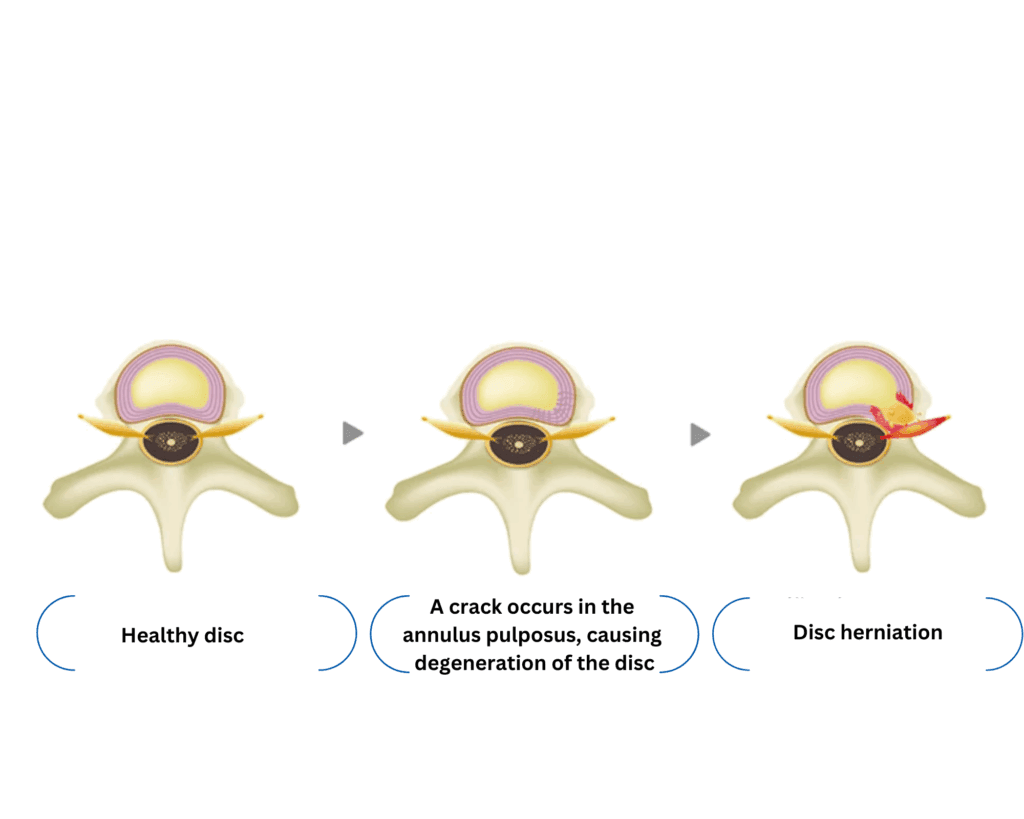Column 🛌Diagnosed with disc Herniation? — Recommended Positions for Sleeping Comfortably🛌
May 26, 2025
One of the most common spine disorders is lumbar disc herniation.
In this article, we will discuss how to sleep when you have disc herniation.
Symptoms and causes of disc herniation
As their mane imply, intervertebral discs are located between the vertebrae. The disc consists of a gelatinous nucleus pulposus in the center and a collagen-rich annulus fibrosus that encloses the nucleus pulposus.
When the annulus fibrosus cracks and the nucleus pulposus protrudes outward as a result, the condition is called disc herniation.

Symptoms of disc herniation
The main symptoms of lumbar disc herniation are back pain, pain in the buttocks and legs, and numbness in the feet. Pain and numbness can occur anywhere in the lower body, but especially pain from the buttocks to the back of the thighs, i.e. sciatica, one of the most characteristic symptoms of lower back herniation.
In this event, the spine bends sideways, making movements difficult, and the pain may intensify when lifting heavy objects. Symptoms may occur suddenly or gradually.
If the nerves are heavily compressed, it may become difficult to pass urine or stools, or incontinence may occur.
Causes of disc herniation
The onset of disc herniation is related to aging, environmental factors, as well as genetic factors.
Incorrect posture, movement, and lifestyle habits (e.g., smoking) put strain on the lower back, and the accumulation of these factors can lead to disc damage and progressive degeneration, resulting in disc herniation.
The following profiles are said to be susceptible to lumbar disc herniation:
![]() Patients over 20 years of age
Patients over 20 years of age
![]() With poor posture (e.g., hunchback)
With poor posture (e.g., hunchback)
![]() Do/used to do high-intensity sports
Do/used to do high-intensity sports
![]() Have a physically demanding job.
Have a physically demanding job.
![]() Are under stress on a daily basis
Are under stress on a daily basis
![]() Smoker
Smoker
![]() Identified as overweight or obese
Identified as overweight or obese
![]() Have a family history of disc herniation
Have a family history of disc herniation
The correct way to sleep with disc herniation
When sleeping on your side
Sleep positioned with the painful side up for greater comfort.
Bending your knees and sleeping with a cushion between your legs can further reduce the strain on your lower back. It is also a good idea to place a towel in the nape of the lower back in order to support it.
The height of your pillow is also important. It is recommended that you choose a pillow of appropriate height so that your head is level with the ground.

When sleeping on your back
We recommend that you place a cushion or a towel fashioned into a ball under your knees and bend them. This will reduce the strain on the lower back.

Sleeping position that are not recommended when you have disc herniation
Patients with disc herniation should avoid the following sleeping positions.
Lying on your stomach
Sleeping on your stomach can aggravate your symptoms, as it puts strain on the disc by warping the lower back.
Sleeping with the painful side down
Sleeping positioned with the painful side down may lead to tension in the muscles around the lower back, decreasing blood circulation and aggravating the pain, which can in turn lead to chronic lower back pain.
Lying on your back with legs stretched out
Sleeping with legs stretched out can stretch the pelvis and aggravate back pain.
If you have disc herniation, it is also crucial to address the underlying cause.
Our clinic provides treatment for disc herniation.
The nucleus pulposus, the cushioning component of the disc, gradually leaks out, causing the disc to gradually lose its volume. A collapsed disc can be the cause of a variety of medical conditions.
With our Cellgel Method, a drug is injected into the cracks of the disc filling them, before turning into a gel that repairs the cracks, thus providing a fundamental treatment. It is characterized by the fact that the volume of the disc is not reduced and the drug remains in the disc as a gel-like implant after treatment, thus preserving the disc.

If you have been diagnosed with disc herniation in the past, please consider a medical examination at our clinic.
Related articles
Understanding Herniated Discs and Receiving the Most Appropriate Treatment For It
What is Lumbar Disc Herniation? Causes of Pain and Symptoms
Is Disc Herniation for Teens and Young Adults on The Rise?
Symptoms and Treatments of Disc Herniation: When Early Detection is Key
Is it true that a herniated disc heals spontaneously?
How to Prevent Disc Herniation: Important Points to Keep in Mind in Your Daily Life
Prevention Rather Than Intervention: Precautions to Take to Prevent Herniated Discs



